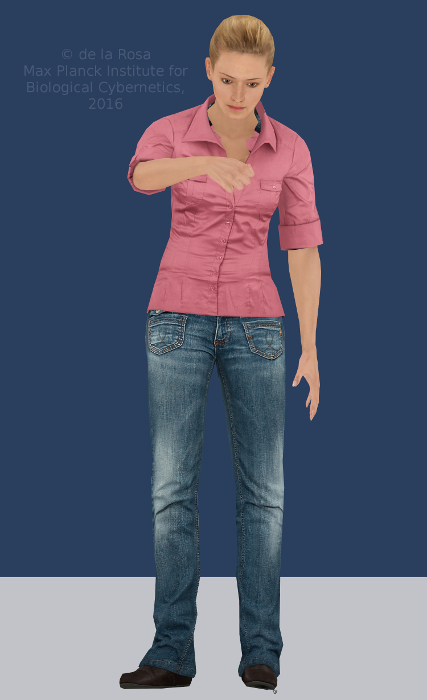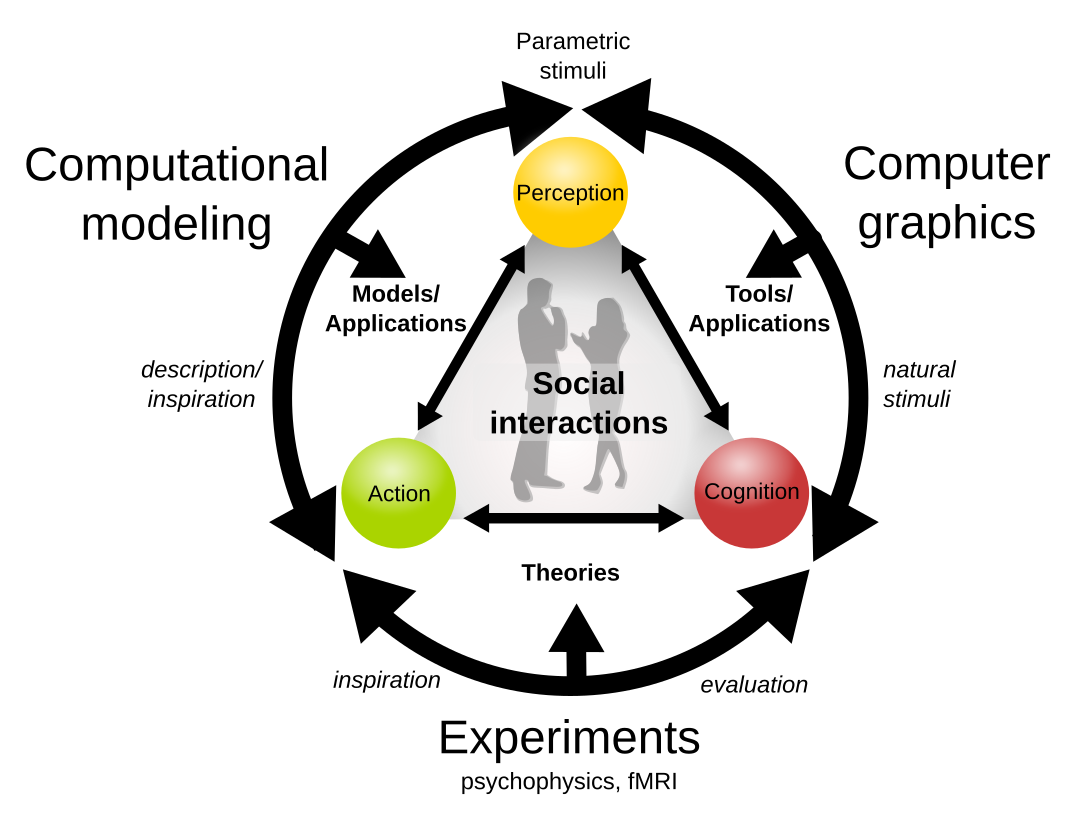Conference proceedings
Saulton A, Bülthoff HH and
de la Rosa S (2016): Objects vs. hand: the effect of knuckle misconceptions on localization task distortions,
46th Annual Meeting of the Society for Neuroscience (Neuroscience 2016), San Diego, CA, USA.
de la Rosa S , Ferstl Y and Bülthoff HH (2016): The face of actions: Evidence for neural action recognition processes
being sensitive for facial identity, 39th European Conference on Visual Perception (ECVP 2016), Barcelona, Spain,
Perception, 45(ECVP Abstract Supplement) 294.
Fademrecht L, Bülthoff HH and
de la Rosa S (2016): Visual processes dominate perception and action during social interactions, 39th European
Conference on Visual Perception (ECVP 2016), Barcelona, Spain, Perception, 45(ECVP Abstract Supplement) 65.
Meilinger T, Strickrodt M, Hinterecker T, Chang D-S, Saulton A, Fademrecht L and
de la Rosa S (2016): Using Virtual Reality to Examine Social and Spatial Cognition, Virtual Environments: Current
Topics in Psychological Research: VECTOR Workshop, Tübingen, Germany.
Fademrecht L, Nieuwenhuis J, Bülthoff I, Barraclough N and
de la Rosa S (2016): Does action recognition suffer in a crowded environment?, 16th Annual Meeting of the Vision
Sciences Society (VSS 2016), St. Pete Beach, FL, USA, Journal of Vision, 16(12) 280.
de la Rosa S , Ferstl Y and Bülthoff HH (2016): Does the motor system contribute to action recognition in social
interactions?, 16th Annual Meeting of the Vision Sciences Society (VSS 2016), St. Pete Beach, FL, USA, Journal of
Vision, 16(12) 268.
Fademrecht L, Bülthoff I, Barraclough NE and
de la Rosa S (2015): The spatial extent of action sensitive perceptual channels decrease with visual eccentricity,
45th Annual Meeting of the Society for Neuroscience (Neuroscience 2015), Chicago, IL, USA.
Chang D-S, Ju U, Bülthoff HH and
de la Rosa S (2015): How different is Action Recognition across Cultures? Visual Adaptation to Social Actions
in Germany vs. Korea, 15th Annual Meeting of the Vision Sciences Society (VSS 2015), St. Pete Beach, FL, USA, Journal
of Vision, 15(12) 493.
de la Rosa, S., Lubkoll, M., Saulton, A., Meilinger, T., Bülthoff, H.H., Canal-Bruland, R. (2015). Motor planning
and contorl: You interact faster with a human than a robot. Tagung experimentell arbeitender Psychologen (TEAP).
(Talk)
Huff, M., Papenmeier, F., Meilinger, T.,
de la Rosa, S. (2015). Semantic relations in aysemtric dynamic social interactions. Tagung experimentell arbeitender
Psychologen (TEAP). (Poster)
Foster, C., Takahashi, K., Kurek, S., Horeis, C., Bäuerle, M. J.,
de la Rosa, S., Watanabe, K., Butz, M.V., Meilinger, T. (2015). Looking at me? Influence of facing orientation
of avatars and objects on distance estimation. Tagung experimentell arbeitender Psychologen (TEAP). (Talk)
Chang D-S., Bülthoff, H.H., &
de la Rosa, S. (2014): Action recognition and the semantic meaning of actions: how does the brain categorize
different social actions?, 12th Biannual Conference of the German Cognitive Science Society (KogWis 2014), Tübingen,
Germany, Cognitive Processing, 15 (Supplement 1) S95. (Talk)
Chang D-S., Bülthoff H.H., &
de la Rosa, S. (2014): Actions revealing cooperation: predicting cooperativeness in social dilemmasfrom the observation
of everyday actions, 12th Biannual Conference of the German Cognitive Science Society (KogWis 2014), Tübingen, Germany,
Cognitive Processing, 15 (Supplement 1) S33-S34. (Poster)
Hohmann M.R.,
de la Rosa S., & Bülthoff H.H. (2014): On the perception and processing of social actions, 12th Biannual Conference
of the German Cognitive Science Society (KogWis 2014), Tübingen, Germany, Cognitive Processing, 15 (Supplement 1)
S46-S47. (Poster)
Fademrecht L., Bülthoff I., &
de la Rosa, S. (2014): A matter of perspective: action recognition depends on stimulus orientation in the periphery,
37th European Conference on Visual Perception (ECVP 2014), Beograd, Serbia, Perception, 43 (ECVP Abstract Supplement)
103. (Poster)
de la Rosa S., Hohmann M., & Bülthoff H.H. (2014): Actions in motion: Separate perceptual channels for processing
dynamic and static action information, 37th European Conference on Visual Perception (ECVP 2014), Beograd, Serbia,
Perception, 43 (ECVP Abstract Supplement) 71. (Talk)
Chang D-S., Bülthoff H.H., &
de la Rosa, S. (2014): Does Action Recognition Depend more on the Meaning or Motion of Different Actions?, 37th
European Conference on Visual Perception (ECVP 2014), Beograd, Serbia, Perception, 43 (ECVP Abstract Supplement)
103. (Poster)
Piryankova IV., Stefanucci JK., Romero J.,
de la Rosa S., Black MJ.., & Mohler B.J. (2014): Can I recognize my body's weight? The influence of shape and
texture on the perception of self, 41st International Conference and Exhibition on Computer Graphics and Interactive
Techniques (SIGGRAPH 2014), Vancouver, Canada. (Talk)
Chang D-S., Bülthoff H.H., &
de la Rosa, S. (2014): Visual Adaptation to Social Actions: The Role of Meaning vs. Motion for Action Recognition,
Conference on Brain and Cognitive Engineering (BCE 2014), Tübingen, Germany. (Poster)
Fademrecht L., Bülthoff I., &
de la Rosa, S. (2014): Influence of eccentricity on action recognition, 14th Annual Meeting of the Vision Sciences
Society (VSS 2014), St. Pete Beach, FL, USA, Journal of Vision, 14(10) 1006. (Poster)
de la Rosa S. , Fuller G., & Bülthoff H.H (2014): Social interaction recognition: the whole is not greater than
the sum of its parts, 14th Annual Meeting of the Vision Sciences Society (VSS 2014), St. Pete Beach, FL, USA, Journal
of Vision, 14(10) 1005. (Poster)
Saulton A., Dodds T., Bülthoff H.H., &
de la Rosa, S. (2014): Body and objects representations are associated with similar distortions, 14th Annual
Meeting of the Vision Sciences Society (VSS 2014), St. Pete Beach, FL, USA, Journal of Vision, 14(10) 845. (Poster)
Chang D-S., Bülthoff H.H., &
de la Rosa, S. (2014): Visual Adaptation to Social Actions: The Role of Meaning vs. Motion for Action Recognition,
79th Cold Spring Harbor Symposium on Quantitative Biology: Cognition, New York, NY, USA. (Poster)
de la Rosa, S.reuber, S., Giese, M.A., Bülthoff, H.H., & Curio, C. (2013). Visual adaptation aftereffects to
actions are modulated by high-level action interpretations. 13th Visual Science Society Annual Meeting, Naples. (Talk)
de la Rosa, S., Miekes, S. , Bülthoff, H.H., & Curio. C. (2012): View dependencies in the visual recognition
of social interactions, 35th European Conference on Visual Perception, Alghero, Italy, Perception, 41(ECVP Abstract
Supplement). (Poster)
Kaulard, K., Schultz, J., Wallraven, C. , Bülthoff, H.H., &
de la Rosa, S. (2012): Inverting natural facial expressions puzzle you, 35th European Conference on Visual Perception,
Alghero, Italy, Perception, 41(ECVP Abstract Supplement). (Poster)
Curio, C. , Giese, M. , Bülthoff, H.H., &
de la Rosa, S. (2012): Motor-visual effects in the recognition of dynamic facial expressions, 35th European Conference
on Visual Perception, Alghero, Italy, Perception, 41(ECVP Abstract Supplement). (Talk)
de la Rosa, S., Giese, M., Bülthoff, H. H., & Curio, C. (2011). The influence of dynamic and static adaptors
on the magnitude of high-level aftereffects for dynamic facial expression, Perception, 40, ECVP Abstract Supplement,
154. (Poster)
Kaulard, K.,
de la Rosa, S., Schultz, J, Fernandez Cruz, A.L., Bülthoff, H.H., & Wallraven, C. (2011). What are the properties
underlying similarity judgments of facial expressions? Perception, 40, ECVP Abstract Supplement,115. (Poster)
Streuber S., &
de la Rosa, S. (2011). The effect of visual information on motor control in social interaction tasks, Perception,
40, ECVP Abstract Supplement, 115. (Poster)
de la Rosa, S., Choudhery, R., & Bülthoff, H. H. (2010): Social interaction recognition and object recognition
have different entry levels, Perception 39, ECVP Abstract Supplement, 12. (Talk)
Kaulard, K., Wallraven, C.,
de la Rosa, S., & Bülthoff, H.H. (2010): Cognitive categories of emotional and conversational facial expressions
are influenced by dynamic information, Perception, 39, ECVP Abstract Supplement, 157. (Poster)
Schillinger, F.,
de la Rosa, S., Schultz, J., & Uludag K (2010): Whole-brain fMRI using repetition suppression between action
and perception reveals cortical areas with mirror neuron properties, Perception, 39(ECVP Abstract Supplement) 54.
(Poster)
Streuber, S., &
de la Rosa, S. (2010): Action prediction in competitive table tennis, Perception 39, ECVP Abstract Supplement,
180. (Poster)
de la Rosa, S. , Choudhery, R., & Chatziastros, A. (2009), Detection, categorization, and identification are
separable component processes of object recognition, Perception 38 ECVP Abstract Supplement, 26. (Poster)
Streuber, S., &
de la Rosa, S. (2009): The role of body and tool-based information in joint action coordination, Perception 38,
ECVP Abstract Supplement, 33. (Poster)
de la Rosa, S. & Chatziastros, A. (2008). Recognising the actions of others is as fast as recognising objects.
Perception, 37, 31. (Poster)
de la Rosa, S., Morgalia, G., & Schneider, B. (2008). Binocular unmasking is important for the detection, categorization
and identification of noise-masked real-life objects. International Congress of Psychology, Berlin, Germany. (Talk)
de la Rosa, S., Gordon, M., & Schneider, B. (2007). Top-down control over visual contrast sensitivity. Perception,
36, 61. (Talk)
de la Rosa, S., Morgalia, G., & Schneider, B. (2005). Search behaviour in conjunctive visual searches with stereoscopic
depth and colour, Perception, 34, 151. (Poster)

